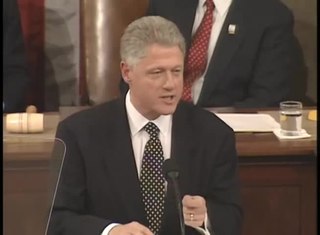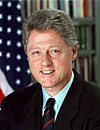
William Jefferson Clinton is an American politician who served as the 42nd president of the United States from 1993 to 2001. A member of the Democratic Party, he previously served as governor of Arkansas from 1979 to 1981 and again from 1983 to 1992. Clinton, whose policies reflected a centrist "Third Way" political philosophy, became known as a New Democrat.

The State of the Union Address is an annual message delivered by the president of the United States to a joint session of the United States Congress near the beginning of most calendar years on the current condition of the nation. The State of the Union Address generally includes reports on the nation's budget, economy, news, agenda, progress, achievements and the president's priorities and legislative proposals.

The Clinton–Lewinsky scandal was a sex scandal involving Bill Clinton, the president of the United States, and Monica Lewinsky, a White House intern. Their sexual relationship began in 1995—when Clinton was 49 years old and Lewinsky was 22 years old—and lasted 18 months, ending in 1997. Clinton ended a televised speech in late January 1998 with the later infamous statement: "I did not have sexual relations with that woman, Ms. Lewinsky." Further investigation led to charges of perjury and to the impeachment of Clinton in 1998 by the U.S. House of Representatives. He was subsequently acquitted on all impeachment charges of perjury and obstruction of justice in a 21-day U.S. Senate trial.

Bill Clinton, the 42nd president of the United States, was impeached by the United States House of Representatives of the 105th United States Congress on December 19, 1998, for "high crimes and misdemeanors". The House adopted two articles of impeachment against Clinton, with the specific charges against Clinton being lying under oath and obstruction of justice. Two other articles had been considered but were rejected by the House vote.

A joint session of the United States Congress is a gathering of members of the two chambers of the bicameral legislature of the federal government of the United States: the Senate and the House of Representatives. Joint sessions can be held on any special occasion, but are required to be held when the president delivers a State of the Union address, when they gather to count and certify the votes of the Electoral College as the presidential election, or when they convene on the occasion of a presidential inauguration. A joint meeting is a ceremonial or formal occasion and does not perform any legislative function, and no resolution is proposed nor vote taken.

The first inauguration of George Washington as the first president of the United States was held on Thursday, April 30, 1789, on the balcony of Federal Hall in New York City, New York. The inauguration was held nearly two months after the beginning of the first four-year term of George Washington as president. Chancellor of New York Robert Livingston administered the presidential oath of office. With this inauguration, the executive branch of the United States government officially began operations under the new frame of government established by the 1787 Constitution. The inauguration of John Adams as vice president was on April 21, 1789, when he assumed his duties as presiding officer of the United States Senate; this also remains the only scheduled inauguration to take place on a day that was neither January nor March.

The 1997 State of the Union Address was given by the 42nd president of the United States, Bill Clinton, on February 4, 1997, at 9:00 p.m. EST, in the chamber of the United States House of Representatives to the 105th United States Congress. It was Clinton's fourth State of the Union Address and his fifth speech to a joint session of the United States Congress. Presiding over this joint session was the House speaker, Newt Gingrich, accompanied by Al Gore, the vice president, in his capacity as the president of the Senate.

The 1999 State of the Union Address was given by the 42nd president of the United States, Bill Clinton, on January 19, 1999, at 9:00 p.m. EST, in the chamber of the United States House of Representatives to the 106th United States Congress. It was Clinton's sixth State of the Union Address and his seventh speech to a joint session of the United States Congress. Presiding over this joint session was the House speaker, Dennis Hastert, accompanied by Al Gore, the vice president, in his capacity as the president of the Senate.

The 1998 State of the Union Address was given by the 42nd president of the United States, Bill Clinton, on January 27, 1998, at 9:00 p.m. EST, in the chamber of the United States House of Representatives to the 105th United States Congress. It was Clinton's fifth State of the Union Address and his sixth speech to a joint session of the United States Congress. Presiding over this joint session was the House speaker, Newt Gingrich, accompanied by Al Gore, the vice president, in his capacity as the president of the Senate.

The 1996 State of the Union Address was given by the 42nd president of the United States, Bill Clinton, on January 23, 1996, at 9:00 p.m. EST, in the chamber of the United States House of Representatives to the 104th United States Congress. It was Clinton's third State of the Union Address and his fourth speech to a joint session of the United States Congress. Presiding over this joint session was the House speaker, Newt Gingrich, accompanied by Al Gore, the vice president, in his capacity as the president of the Senate.
The 1995 State of the Union Address was given by the 42nd president of the United States, Bill Clinton, on January 24, 1995, at 9:00 p.m. EST, in the chamber of the United States House of Representatives to the 104th United States Congress. It was Clinton's second State of the Union Address and his third speech to a joint session of the United States Congress. Presiding over this joint session was the House speaker, Newt Gingrich, accompanied by Al Gore, the vice president, in his capacity as the president of the Senate.

The 1994 State of the Union Address was given by the 42nd president of the United States, Bill Clinton, on January 25, 1994, at 9:00 p.m. EST, in the chamber of the United States House of Representatives to the 103rd United States Congress. It was Clinton's first State of the Union Address and his second speech to a joint session of the United States Congress. Presiding over this joint session was House speaker Tom Foley, accompanied by Vice President Al Gore, in his capacity as the president of the Senate.
The 1992 State of the Union Address was given by the 41st president of the United States, George H. W. Bush, on January 28, 1992, at 9:00 p.m. EST, in the chamber of the United States House of Representatives to the 102nd United States Congress. It was Bush's third and final State of the Union Address and his fourth and final speech to a joint session of the United States Congress. Presiding over this joint session was the House speaker, Tom Foley, accompanied by Dan Quayle, the vice president, in his capacity as the president of the Senate.

Barack Obama served as the 44th President of the United States from 2009 to 2017. Before his presidency, he served in the Illinois Senate (1997–2004) and the United States Senate (2005–2008).

The impeachment trial of Bill Clinton, the 42nd president of the United States, began in the U.S. Senate on January 7, 1999, and concluded with his acquittal on February 12. After an inquiry between October and December 1998, President Clinton was impeached by the U.S. House of Representatives on December 19, 1998; the articles of impeachment charged him with perjury and obstruction of justice. It was the second impeachment trial of a U.S. president, preceded by that of Andrew Johnson.
The following is a timeline of the presidency of Bill Clinton, from January 1, 1995 to December 31, 1995.
The following is a timeline of the presidency of Bill Clinton, from January 1, 1996, to December 31, 1996.
The following is a timeline of the presidency of Bill Clinton from January 1, 1997, to December 31, 1997.
The following is a timeline of the presidency of Bill Clinton, from January 1, 2000 to January 20, 2001.

Joe Biden, the 46th president of the United States, addressed a joint session of the United States Congress on Wednesday, April 28, 2021, the eve of his 100th day in office. It was his first public address before a joint session. Similar to a State of the Union Address, it was delivered before the 117th United States Congress in the Chamber of the House of Representatives in the United States Capitol. Presiding over this joint session was the House speaker, Nancy Pelosi, accompanied by Kamala Harris, the vice president in her capacity as the president of the Senate―the first time two women and two Californians presided over an address to Congress, seated on the rostrum behind the president.

















